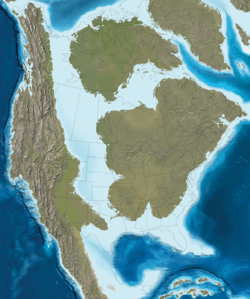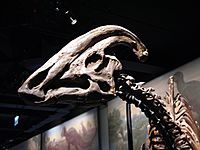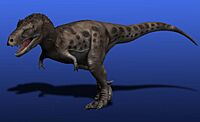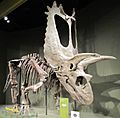Fruitland Formation facts for kids
Quick facts for kids Fruitland FormationStratigraphic range: Campanian ~76.3–75Ma |
|
|---|---|

Fruitland Formation at the Bisti Wilderness
|
|
| Type | Geological formation |
| Sub-units | Fossil Forest Member Ne-nah-ne-zad Member |
| Underlies | Kirtland Formation |
| Overlies | Pictured Cliffs Sandstone |
| Lithology | |
| Primary | Sandstone |
| Other | Shale, coal |
| Location | |
| Coordinates | 36°45′07″N 108°26′31″W / 36.752°N 108.442°W |
| Approximate paleocoordinates | 43°30′N 79°36′W / 43.5°N 79.6°W |
| Region | |
| Country | |
The Fruitland Formation is a special layer of rock found in the San Juan Basin. This area is located in the states of New Mexico and Colorado in the United States. Scientists study this rock layer to learn about Earth's past.
The Fruitland Formation holds many fossils. These fossils tell us that the rocks formed during the Campanian age. This was a time period about 76 to 75 million years ago. It was part of the Cretaceous period, when dinosaurs roamed the Earth.
Contents
What is the Fruitland Formation?
The Fruitland Formation is made of different kinds of rock. You can find layers of sandstone, shale, and coal here. These rocks formed in a wet, swampy area. It was like a big delta, where rivers met the sea. The climate was warm and humid, with wet and dry seasons.
This rock layer sits on top of the Pictured Cliffs Sandstone. Above the Fruitland Formation is the Kirtland Formation. These layers show how the land changed over millions of years.
How the Rocks Formed
Long ago, a large inland sea covered parts of North America. This was called the Western Interior Seaway. The Pictured Cliffs Sandstone formed in the shallow waters near the edge of this sea. It was like sand building up near barrier islands today.
As the sea slowly pulled back, the land became swampy lowlands. This is where the Fruitland Formation began to form. Over about one million years, mud, sand, and plant material built up. This material eventually turned into the sandstone, shale, and coal we see today.
Scientists have used special dating methods to find the age of these rocks. The bottom of the Fruitland Formation is about 76.3 million years old. The top part, where it meets the Kirtland Formation, is about 75 million years old.
Parts of the Formation
The Fruitland Formation is divided into two main parts, called members:
- The Ne-nah-ne-zad Member is the lower part. It formed between 76.3 and 75.5 million years ago.
- The Fossil Forest Member is the upper part. It formed between 75.5 and 75 million years ago. This upper part shares some fossils with the Kirtland Formation above it.
Ancient Animals of the Fruitland Formation
The Fruitland Formation is famous for its dinosaur fossils. Scientists have found bones and even footprints of different dinosaurs here.
Ornithischian Dinosaurs
These dinosaurs were often plant-eaters. They had a special bone in their hip that pointed backward, like a bird's.
- Hadrosaurs: These were "duck-billed" dinosaurs. A giant footprint found here suggests a very large hadrosaur lived in the area. It was even bigger than Shantungosaurus, one of the largest known hadrosaurs.
- Parasaurolophus: This dinosaur is known for its long, curved crest on its head. One important fossil of Parasaurolophus cyrtocristatus was found in the Fossil Forest Member.
- Pentaceratops: This "five-horned face" dinosaur was a type of horned dinosaur. Several fossils of Pentaceratops sternbergii have been found. This dinosaur also lived in the Kirtland Formation.
- Stegoceras: This was a smaller, dome-headed dinosaur. A nearly complete skull part of Stegoceras novomexicanum was found here. It also lived in the lower Kirtland Formation.
Saurischian Dinosaurs
These dinosaurs often had hips like lizards. This group includes both meat-eating dinosaurs (theropods) and long-necked plant-eaters (sauropods).
- Bistahieversor: This was a large meat-eating dinosaur, similar to the famous tyrannosaurs. Some parts of its skull have been found in the Fossil Forest Member.
- Dromaeosaurs: These were bird-like, meat-eating dinosaurs, known for their sharp claws. Only teeth have been found, so we don't know the exact type.
- Ornithomimids: These were "ostrich-mimic" dinosaurs. They looked a bit like modern ostriches.
- Troodontids: These were small, smart, bird-like dinosaurs. Some teeth found here might belong to this group.
What Else is Found Here?
The Fruitland Formation is important for more than just fossils. It also contains valuable natural resources.
Coal and Methane
The formation has layers of bituminous coal. This type of coal is mined in some areas. Since the 1980s, the coal beds have also produced a lot of coalbed methane. Methane is a natural gas found in coal.
This area, especially where Colorado and New Mexico meet, is one of the best places in the United States for coalbed methane. The methane from the Fruitland Formation, both from mining and natural leaks, contributes to something called the Four Corners Methane Hot Spot. This is an area where satellites have detected a lot of methane in the air.
Images for kids
-
Fruitland Formation at the Bisti Wilderness














